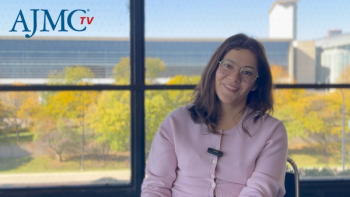
Patient-Reported Outcomes in COPD
The role of assessing and measuring patients’ feedback to improve how chronic obstructive pulmonary disease is managed.
Transcript
Neil B. Minkoff, MD: For both of you, let me ask this question: Because clinical practice and trying to fit patients in while doing research and other things can be challenging and hectic, are you doing PRO [patient-reported outcome] data collection in your clinics or offices?
Byron Thomashow, MD: With the COPD Foundation, we’re doing it all the time. In my clinical practice, a little less. That’s my honest answer.
Frank C. Sciurba, MD, FCCP: We have incorporated smart tablets in our waiting room, for patients to fill out forms. We sometimes have problems consistently giving a tablet to them and getting it to work, but we’re getting better. But yes, they’re helpful to track it over time to see. This little mobile app that Byron has an easy-to-use CAT [chronic obstructive pulmonary disease assessment test] score. I give it to them often while I’m doing the physical examination, listening to their lungs, and they have to click 8 slots, on a scale of 0 to 5, and you come up with your CAT score. Greater than 10 is a symptomatic patient.
Neil B. Minkoff, MD: Let me ask you a question, and I’ll give you a hypothetical based on 1 of the examples you gave earlier. The guy who can do 18 holes of golf only if he used the cart is now feeling well enough that he can do 18 holes again without using the cart, or maybe 9 holes. But he’s showing improvement. You’re not really seeing a lot of difference in his PFT [pulmonary function test] scores. What do you do with him?
Frank C. Sciurba, MD, FCCP: It depends whether they’re maximized or not. I think you do the happy dance and say, “We’ve actually got a marker that says we’ve made progress.” This is management of a chronic disease. You don’t completely eradicate their symptoms or their physiological abnormality, but you optimize their quality of life and their function. You add therapies if they still have residual deficits, until they don’t improve any more, and that’s what we try to do.
Byron Thomashow, MD: And you push the need to exercise.
Frank C. Sciurba, MD, FCCP: Absolutely.
Byron Thomashow, MD: Pulmonary rehab is not just exercise. It has breathing techniques. It is a social network. It’s 1 of the issues, Maria, that you were talking about in doing telemedicine. Considering where we are with pulmonary rehab, I think we all agree that we need to figure out a way to get that more into their homes. The 1 concern with that is you lose that social component of pulmonary rehab, which is very important. But pulmonary rehab exercise is really a critical issue going forward. Again, it helps the person in many, many different ways. People need to understand that this is almost always a preventable and treatable disease, and we need to do a better job doing those things.
Neil B. Minkoff, MD: Let me ask you a follow-up to that, which is, where are the differences between how your patients perceive improvement versus how you perceive improvement? Are there significant differences?
Byron Thomashow, MD: It’s all about what the patient perceives. If the patient doesn’t feel they’re doing well enough, then I need to do more. It comes back to, again, the concept of goals. In the mobile app that Frank mentioned before, there’s a provider component to it, but there’s now a patient component to it as well, where they can put in their goals and work toward achieving those goals. But it has much less to do with me than it does with them. If they’re not satisfied, then I need to do more. As Frank can tell you, there are times when there isn’t any more we can do. But before we leave this point…
Neil B. Minkoff, MD: I don’t want to leave the point. I want to follow up.
Byron Thomashow, MD: I think it’s important to understand. We talked a lot about medicine. We talked a lot about exercise programs. There are a couple of other things just to put on the table.
Frank C. Sciurba, MD, FCCP: Just to add a little to the question you asked, what if you think they’re doing better, but the patient says they’re not doing better? Often, the patient is right and you’re looking at the wrong thing. If you’re looking and say, “Well, your FEV1 [forced expiratory volume in 1 second] is a bit improved, and it’s stabilized.” But the patient says, “I don’t sense it. I don’t feel better.” Well, the thing limiting them may not be their lung mechanics at that point. It may be, leading into what Byron said, that they’re desaturating, or they have pulmonary hypertension, or they have cardiac comorbidity. If those are the dominant limiting factors, then improving their lung function a little isn’t going to make a huge difference. Or if it’s the flare-ups with the exacerbations, the day-to-day variability that bothers them the most, and the cough and sputum, that may not be reflected by a little improvement in lung function.
Newsletter
Stay ahead of policy, cost, and value—subscribe to AJMC for expert insights at the intersection of clinical care and health economics.






























































